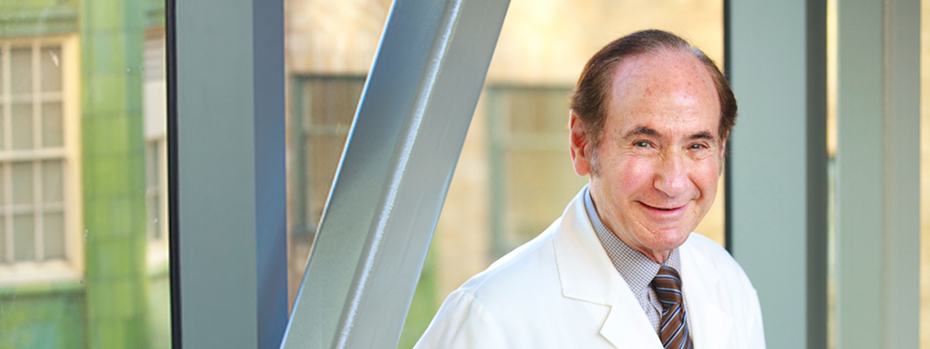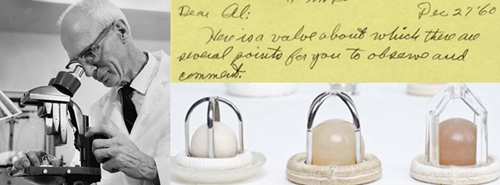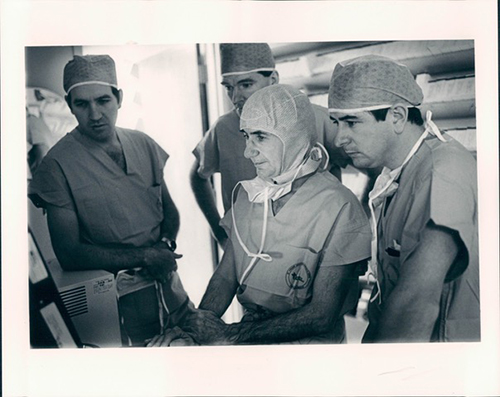Meet Dr. Albert Starr

Dr. Starr, inventor of the first artificial heart valve, revolutionized cardiovascular medicine
Hundreds of thousands of hearts kept beating because of Dr. Albert Starr’s bold innovations in heart surgery.
A renowned cardiovascular surgeon and OHSU Knight Cardiovascular Institute professor emeritus, Dr. Starr co-invented and implanted the world’s first artificial heart valve at OHSU in 1960. Over the next 50 years, about 800,000 Starr-Edwards valves saved lives in Oregon and around the world.
OHSU remembered Dr. Starr as an innovator and inspiration after he died Dec. 11, 2024, at age 98.
Finding his path to heart surgery
Starr, M.D., was born on June 1, 1926, in New York City and educated in New York public schools. He played the piano in jazz bands to help pay for liberal arts courses at Columbia College (now Columbia University).
At the time, Columbia teemed with physicists working on the Manhattan Project. It was the early days of molecular physics, and he considered both physics and economics as a career, but medicine won his heart. “Medicine became my music, so to speak,” Dr. Starr said in a 2006 interview with the OHSU Oral History Project.
After graduating from Columbia College in 1946, he enrolled in the Columbia College of Physicians and Surgeons (now Columbia University Vagelos College of Physicians and Surgeons). Dr. Starr earned his medical degree in 1949 in just three years.
In 1950, Dr. Starr completed an internship at Johns Hopkins Hospital under Alfred Blalock, M.D., FACS, a pioneer in treating shock and “blue baby” syndrome. That year, he began a residency in general and thoracic surgery at Columbia Bellevue (now NYC Health + Hospitals/Bellevue) and Columbia Presbyterian (now New York-Presbyterian /Columbia University Irving Medical Center) hospitals until he was drafted for surgical service during the Korean War.
In Korea, he started as a battalion surgeon near the front lines, at times surrounded by enemy forces. Later he transferred to the 8076 Mobile Army Surgical Hospital (MASH) where he honed his skills in surgery. In 1953, Dr. Starr resumed training at Columbia Presbyterian, completing his residency in 1957.
Heart breakthroughs at OHSU
That year, the University of Oregon Medical School’s (now OHSU) chief thoracic surgeon recruited Dr. Starr to come to Oregon and set up the state’s first open-heart surgery program.
Dr. Starr used a $10,000 grant from the Oregon Heart Association to train a surgery team to treat patients with congenital heart disease. In 1958, Dr. Starr performed Oregon’s first pediatric open-heart surgery on a 7-year-old girl with a congenital hole in her heart at OHSU Doernbecher Children’s Hospital.
Inventing the artificial heart valve
In 1958, Dr. Starr met retired hydraulic engineer M. Lowell Edwards to discuss creating an artificial heart. Their conversation changed the course of cardiovascular medicine.
An avid inventor with many patents, Edwards wanted to apply his knowledge of hydraulics, or pumps, to the human heart, another kind of pump. The much younger Dr. Starr embraced the idea and began a partnership with Edwards that would last years.
Rather than start with the whole heart, Dr. Starr proposed focusing on one valve at a time. They examined the physiology of a normal mitral valve and modeled their invention after it. Located on the left side of the heart, the mitral valve opens and closes like a pump, allowing blood to flow forward from your left atrium to your left ventricle (and not backward). Edwards brought in engineers experienced in weapons systems, and together they tested ideas and perfected the new valve within two years.

Dr. Starr’s surgical firsts
Two years after performing Oregon’s first pediatric open-heart surgery, Dr. Starr implanted the world’s first successful artificial mitral valve in a 52-year-old man with end-stage mitral valve disease. The patient lived in good health for more than a decade until he died in a ladder fall. That same year, Edwards incorporated Edwards Laboratories to manufacture and market the Starr-Edwards valve.
Over the next few years, Dr. Starr continued to expand uses of the Starr-Edwards valve, performing the world’s first triple-valve replacement surgery at OHSU in 1963.
Before the artificial valve was available, “patients were literally dying in the hospital of mitral valve disease and the cardiologists just threw up their hands. There was nothing that they could do,” Dr. Starr reflected in an interview about his 2007 Lasker Award win. The Lasker Award is considered America’s Nobel Prize.
The Starr-Edwards valve changed that for good. The mechanical ball-and-cage valve fits three heart positions: mitral, aortic or tricuspid. It has saved hundreds of thousands of lives and continues to fuel research for another innovation: a permanent artificial heart.
In 1985, Dr. Starr performed Oregon’s first heart transplant at OHSU on a 44-year-old man from Battle Ground, Washington.
A legacy of cardiovascular leadership
Dr. Starr led OHSU’s heart surgery program until 1964, when he was appointed head of a joint cardiac surgery program between OHSU and Providence Health System. Over the years he continued to focus on surgical corrections of congenital heart disease. In 1986, he was appointed director of the Providence Heart & Vascular Institute, and in 2004 he was tapped to direct bioscience research and development at Providence.

Dr. Starr returned to OHSU in 2011 as a distinguished professor of cardiovascular medicine and special adviser to then-OHSU School of Medicine Dean Mark Richardson, M.D., M.B.A., and then-OHSU President Joe Robertson, M.D., M.B.A. He was co-director of the OHSU Knight Cardiovascular Institute from 2012 to 2018.
Dr. Starr was professor emeritus of surgery at OHSU Knight Cardiovascular Institute at the time of his death. His legacy continues to inspire heart surgery innovations in Oregon and around the world.
More about Dr. Starr
- Oregon Experience: How two Oregonians invented the world's first successful artificial heart valve
- 2006 OHSU interview: The Starr-Edwards heart valve origin story
- NCBI: 49 years of normal functioning Starr–Edwards aortic valve prosthesis
- Endovascular Today: An interview with Albert Starr, M.D.
- OHSU remembers Albert Starr, M.D.
Dr. Starr’s awards
- 1966: Susan and Theodore Cummings Humanitarian Award, American College of Cardiology
- 1988: Distinguished Scientist Award, American College of Cardiology
- 2001: d’Honneur au grade de Chevalier Award, Paris, France
- 2007: Lasker-DeBakey Clinical Medical Research Award
- 2009: Phoenix Award for Innovation
- 2011: Oregon Historical Society History Makers Medal
- 2013: Oregon Bioscience Association Lifetime Achievement Award
- 2015: Institut de France Grand Prix Scientifique
Resources for media
Download photos and other resources about Dr. Starr.